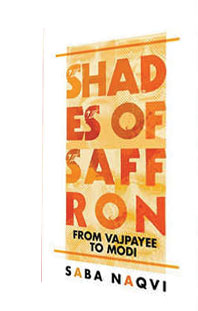Shades of Saffron: from Vajpayee to Modi, Saba Naqvi, Westland Publications; Rs.599, Pages 288
 One of the main challenges institutions of Indian democracy are facing is decline of the liberal professions.
One of the main challenges institutions of Indian democracy are facing is decline of the liberal professions.
Journalists, lawyers, professors were supposed to be the front line of the army fighting for the rights of the governed. Today, they are seen more as collaborators of the governors. Why that is so is the subject matter of a separate debate.
However, one reason is certainly worth exploring. The powerful and influential sections of these professions seem to be divorced from serious pursuit of scholarship without which these professions can only produce technicians who, at their best, will be useful tools for their employers but will have nothing to contribute to our collective life.
Senior journalist Saba Naqvi’s latest book traces the journey of the BJP governments and politics from the Vajpayee era to Modi. The initial chapters of the book are set in the late 1990s and deal with personalities and events which have been important milestones in the emergence of the BJP as the pre-eminent pan-India political party.
Saba writes with sufficient sympathy about several BJP leaders with whom she is ideologically not in sync, like Vajpayee, Advani, Govindacharya, except Modi. She is an engaging storyteller. Written in a conversational, journalistic style with inevitable doses of power gossip, the book reads like a story and is fairly informative. But it remains a fact-based journalistic work and doesn’t attempt any deep or long-term political, historical analysis of the tectonic movements of Indian politics in the past couple of decades.
Regrettably, Shades of Saffron is not a work of history and lacks serious political analysis. It tells us that Vajpayee and Modi represent different shades of saffron. A serious reader would be interested in learning why. Why did the RSS which was supposed to wield the remote control, become subservient to the Nehruvian regime of Vajpayee and even more to the dominant regime of Modi? How did a fairly federal democratic BJP become a one man show after just one election? How did BJP dominate the 2014 parliamentary elections after doing nothing as the main opposition party between 2004-2014 while scoring one self-goal after another? What did the integral humanism of Deendayal Upadhyaya mean for Indian politics and how much of it was manifested in the BJP governments of Vajpayee and/or Modi?
These questions are not seriously answered. It does not ask why the Nehru parivar has shrunk and the sangh parivar has ballooned in the last two decades even though both have had ten years of power at the Centre. It is perhaps the nature of Indian political journalism which produces such unsatisfactory narratives. Journalists like Naqvi get used to khabar journalism in which a lot of importance is accorded to gossip, palace intrigue etc, which make readable sensational copy for a weekly or daily, but is trivia for individuals with deeper interest in politics and examining the long-term movements of political forces.
The enjoyment our political journalists get in circulating gossip is evident in how Govindacharya is dealt with in this book. He is arguably one of the most serious thinkers the right wing has produced in the past 30-40 years. He propagated social engineering in the late 1990s and promoted OBC/Dalit leaders such as Sushil Modi, Uma Bharti, Bangaru Laxman and others. His vision was to realign BJP, hitherto a largely upper caste-based party, with the deprived sections of society, to bring greater depth to its support base. The upper caste BJP leaders did everything possible to sabotage this ambitious project at that time.
Later, the Modi-Shah duo picked up this theme and cleverly packaged Modi as the OBC prime ministerial candidate from a poor tea-vendor background, with great success in the 2014 elections. Yet Govindacharya finds mention in the book largely for the mask (mukhauta) controversy and how Vajpayee used to denigrate him by calling him Rajnishacharya/Dronacharya. His deeper political projects such as swadeshi (a version of Gandhian socialism) and social engineering are mentioned merely in passing, though later, social engineering during Modi’s campaign does come up in the book, to a limited extent.
Thus we’ve got a book, but not scholarship. That brings me to the question I started this review with. How do we get scholarship back into our liberal professions? I suppose many of us should make this attempt. Naqvi has tried to, but failed.
Santosh Kumar (Book Review, September 2018)























